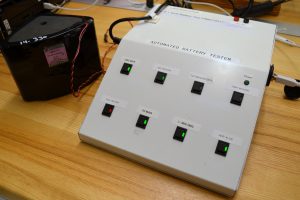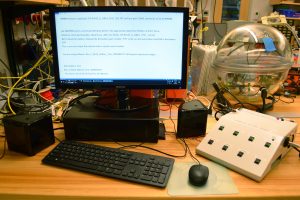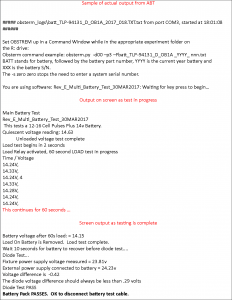WHOI Automated Battery Tester (ABT)
All WHOI seismometers have batteries that power their electronics while on the seafloor. This requires that every battery be thoroughly tested prior to being installed in a glass sphere or aluminum tube. As a result, when outfitting large numbers of instruments at one time, the number of batteries to be tested quickly grows.
Most of the batteries used in WHOI seismographs are lithium primaries. By definition, a primary battery is a portable voltaic cell that is not rechargeable. A reverse charge must never be applied to a lithium primary battery because a sudden increase in internal temperature could cause it to spontaneously combust.
For these reasons, testing is not only time consuming, but it comes with the risk of fire or explosion due to the volatile nature of lithium primary batteries.
Why did WHOI develop the ABT?
The ABT automates the testing process required of all battery types used in WHOI ocean-bottom seismographs while also reducing the dangers inherent in handling and testing. It also greatly decreases personnel time needed to performing battery testing prior to deployment, which frees up group members to perform other tasks.
The straightforward design of the ABT means that battery testing may now be performed by almost any non-technical personnel, a critical advantage when cruises follow close together and technical staff are in short supply.
Why is the ABT faster and safer than Manual Testing?
| Feature | Automated Battery Tester | Manual Testing |
|---|---|---|
| Handling | Handling reduced. One connection made to battery. Internally located supply. | Operator required to make multiple connections, variable power supply etc. |
| Voltage | No probing with a voltmeter is required, tester A-D records voltage. | Operator to use a voltmeter to make measurements. |
| Current | Current is calculated and recorded by the ABT. | Operator to use an ammeter to monitor current. |
| Operator Presence | The operator does not have to monitor test equipment while testing. | Operator was required to watch the meter while timing the process. |
| Results | There are no judgment calls, removing subjectivity of the operator. | Results were subjective, depending on the operator. |
| Record | The tester reports the revision the battery was tested to and creates a digital record of the test results, serial numbers and date of test. | No question of revision the battery was tested to or if proper procedure was followed and if the correct values are recorded on the check sheet. |
| Speed | Diode test is performed in milliseconds. | Diode test was performed manually. |
Key Features
Tests Performed by ABT
- Open-circuit voltage. The battery voltage is sampled and the value written to a digital file.
- Loading test. A load resistor is switched across the battery drawing approximately 1 A of current—typically the highest draw the battery will see inside of a WHOI seismograph.
- Presence of a blocking protection diode. The blocking diode prevents any attempt to charge the lithium primary.
Digital Record
- A text file is stored with file name saved as the battery serial number and battery pack part number. The stored text file contains the results of each of the three tests along with the values read.
